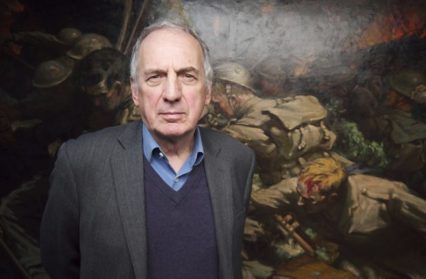Visions of World War One, BBC Wales’ documentary about the Welsh art which arose during the ruthless wartime years, is reviewed by Gary Raymond.
Visions of World War One is an ambitious documentary, attempting in its all too brief 43-minutes to cover a subject vast enough to often render the parameters of it a little difficult to grasp. How did Welsh artists respond to the experience of this new kind of warfare, one where the carnage of previous, even recent conflicts, was to be enhanced so dramatically by the industrialisation and globalisation of the war? This would be a tall enough challenge in itself, but here we are taken from the visceral action painting of Christopher Williams through the propaganda poster art of the London Underground and even to the work of Belgian refugees holed up at Gregynog and looked after by the Davies sisters.
In many ways the documentary does a marvellous job. If the history aspect, the scene setting and contextualising, is a little cliché-ridden it can be excused; there is plenty around at the moment for even the most uninformed to fill in their educational blind spots. But a little backdrop is needed, so this is the “war to end all wars” and presenter Kim Howells talks of the “futility of war” etc. Howells, former minister in the Foreign Office, orates with authority. He has been in war zones, and even sketched in them; he is an artist and art critic. BBC Wales rarely, it seems, hand over the reins to someone as suitable as this for a subject. Howells also has a bit of what BBC Wales always seem to be after in their presenters – there is something of the pub conversationalist about him; an affable, amiable, knowledgeable chap.
And it is a relief to see a BBC Wales documentary that is trying to say something important, and not just tick some boxes. This is not just a perfunctory roll call of sketches and paintings from the front line.
There are quite a few surprises. The Davies sisters brought Belgian refugees over to Gregynog, it turns out, with an eye to upping the game of Welsh artists, who they felt had a lot to learn from the Europeans, especially those coming from the traditions of the lowlands. Carey Morris’ eerie nightscape of Boesinghe Chateau was painted on the battlefield, after which he lost his paints, and had to continue his visual documentations with charcoal. Many connoisseurs of Welsh painting may know these stories, but how many connoisseurs of Welsh painting are there? That Howells goes to interview Ann Rhys, a friend of Carey Morris’ who has two of his etchings hanging in her hallway projects a remarkable sense of connectivity with the past that many of the documentaries on this subject have missed.
Newport’s Bert Thomas, a cartoonist for Punch no less either side of the war, drew a postcard to raise money for tobacco for the troops; “Arf a mo’, Kaiser” was a 10 minute sketch that brought in a quarter of a million pounds for the roll ups and pipes of both the men in combat and in the hospitals. But Thomas’ art, on reflection, does more than just a job of work. It is a symbol of the irreverent Tommy, it speaks of the camaraderie, the attitude of the regular soldier. It says something about the working class of the nation. The programme argues convincingly that cartoons and poster art deserve just as much consideration as testaments to the war experience as oils and epic battleground panoramas.
Inevitably, and rightly, much time is spent on the work of David Jones, who has commanded the attention of not only his own BBC documentaries this season, but also that of National Theatre Wales and Welsh National Opera in the last twelve months.
It has been Jones’ poetry that has wowed many, however, and it is important here that Howells pays tribute to Jones’ first, and prolific, calling: the visual arts. Jones sketched constantly the daily drudgery of trench life. His epic poem, In Parenthesis, is his masterpiece centring on the massacres of Mametz Wood, the Welch Division’s famous and bloody encounter at The Somme, but his sketches and painting build a larger, more accessible impression of the soldier’s life.
Mametz is a focal point for the programme as it has been for so many World War One remembrances around Wales. And Christopher Williams’ gory and oddly soulless painting, “The Welsh at Mametz Wood”, understandably is given much attention. And things begin to come together here, that perhaps the lines drawn between artists are not along the borders of medium, but rather along the borders of authenticity. Cartoonists such as Thomas, poster artists, and painters such as Williams, commissioned by Lloyd George and sent out to Mametz after the battle to paint his enormous homage, are in the realm of theatre, of propaganda, of making war hard but no more real. They are a thousand miles away from the works of David Jones, of cartoonist Frank Brangwyn, admonished for posters that were too realistic, CRW Nevinson, and Carey Morris, feverishly painting as the shells popped in the sky above him.
If Visions of World War One tries to pack too much in (it hardly touches on photography, sculpture), it still lands blows, still makes some interesting correlations across a messy and under-documented subject; and at its least it is a programme that will make you want to explore further the rich, diverse, and not to mention considerable, talents in Welsh art of the period.



 Enjoyed this article? Support our writers directly by buying them a coffee and clicking this link.
Enjoyed this article? Support our writers directly by buying them a coffee and clicking this link.








